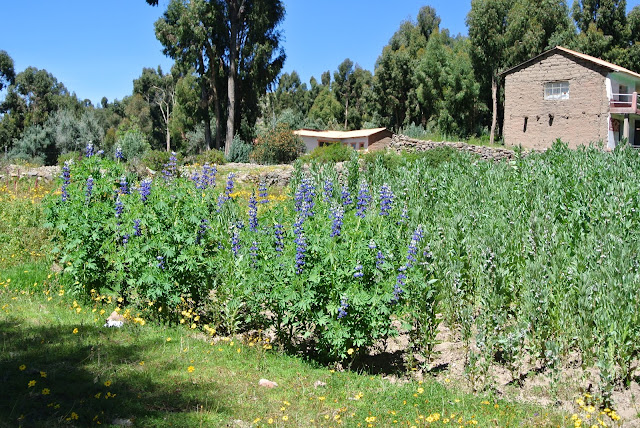A narrative story of my last day (or days, I guess) in the beautiful country of Peru by way of my journal...
Day 11 in Peru
March 26, 2012
March 26, 2012
Flashback to the Uros Islands
On the boat ride to Amantaní yesterday, we stopped at the Uros Islands.
They're a lot smaller than I expected them to be after reading about them in my
travel guide: only about two hundred square feet. They are packed tightly with
little reed-built houses, except for a relatively spacious circle in the
center, which is filled with evenly spaced vendors of small trinkets and
handmade crafts.
I have to admit, I was a bit disappointed; it was all simply too commercialized for my taste, I think... There wasn't much of a culture to experience, as I thought there would be. However, I did find something to speculate about in concern with the living conditions: there was absolutely no electricity or running water... In fact, I didn't even see a bathroom or a kitchen at all.
Dad said that he didn't believe they could actually survive with the minute resources they had on the island we set foot on, and hypothesized a giant conspiracy: that the people on the island didn't actually live there, and just came there to vend their goods during the day. I would be one of the first to admit his points are valid, but I'm not sure that I can quite bring myself to believe his suggestion for the sake of intrigue.
On a different note, aside from the cultural aspects (which may or may not be staged) about the reed islands, there are historical and technical aspects which I believe I can trust to be reliable enough.
History: The Uros Islands were built by the Aymara people of Bolivia as a means if escaping the Spanish in the heat if their conquest, according to the guide on yesterday's tour boat.
How they're built: Basically, the islanders cut huge cubes if sod, nail them firmly with wooden stakes in each of their four surface corners, and then use rope to tie multiple cubes of the sod together. Afterwards, they layer their homemade island with fresh reeds from the lake, which turn brown and are continually replaced. Maintained properly, an island can last for forty years. (This, also, is according to our boat guide.)
So how don't they float away? Oh, each island has eight anchors.
I have to admit, I was a bit disappointed; it was all simply too commercialized for my taste, I think... There wasn't much of a culture to experience, as I thought there would be. However, I did find something to speculate about in concern with the living conditions: there was absolutely no electricity or running water... In fact, I didn't even see a bathroom or a kitchen at all.
Dad said that he didn't believe they could actually survive with the minute resources they had on the island we set foot on, and hypothesized a giant conspiracy: that the people on the island didn't actually live there, and just came there to vend their goods during the day. I would be one of the first to admit his points are valid, but I'm not sure that I can quite bring myself to believe his suggestion for the sake of intrigue.
On a different note, aside from the cultural aspects (which may or may not be staged) about the reed islands, there are historical and technical aspects which I believe I can trust to be reliable enough.
History: The Uros Islands were built by the Aymara people of Bolivia as a means if escaping the Spanish in the heat if their conquest, according to the guide on yesterday's tour boat.
How they're built: Basically, the islanders cut huge cubes if sod, nail them firmly with wooden stakes in each of their four surface corners, and then use rope to tie multiple cubes of the sod together. Afterwards, they layer their homemade island with fresh reeds from the lake, which turn brown and are continually replaced. Maintained properly, an island can last for forty years. (This, also, is according to our boat guide.)
So how don't they float away? Oh, each island has eight anchors.
Scenes from the Uros Islands follow...
The Forty-eight Hour Day: Phase One
Dad woke up feeling
better today (which I guess, technically, is yesterday, the twenty-fifth), and
Flora fixed us all breakfast. We said goodbye soon after, and bought a few of
her homemade hats just before Madeline left for school in a blue uniform
sweater and messy pink sweatpants.
We hopped back aboard the tour boat
that we took to Amantaní and headed for the Isla Taquile for a short hike and
visit.
Below are pictures I took on Isla Taquile...
The Forty-eight Hour Day: Phase Two
Airports... Airplanes... We caught our first of what is projected to be
four total flights back home at around 7:00 PM on the twenty-fifth
(yesterday— but that day sort of melds with today).
Arriving in the Lima airport at about
midnight with a layover of eight or so hours before the Lima-Miami flight (the
second leg of the grand voyage), we slept on the floor of the airport for some
time, hugging our luggage to protect it from thieves. Needless to say, now on
the third airplane of the day, Cara, Dad, and I all smell like old shoes. A
nice, hot shower may even make my sadness at leaving Peru disappear for a
little while.














































